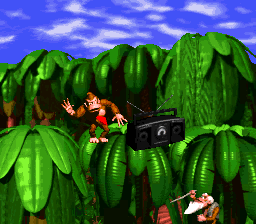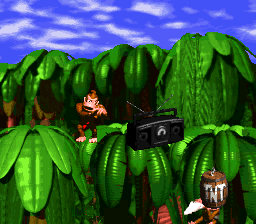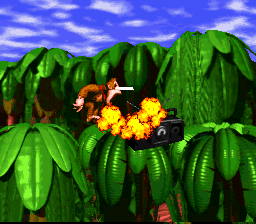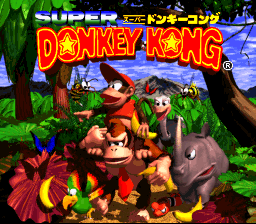


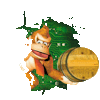
In the mid-90s, gaming as a medium was heating up to fever pitch. The Super Nintendo Entertainment System and the Sega Genesis (or Mega Drive) were duking it out, practically toe-to-toe. The SNES was newer and generally superior hardware, and Sega was trying to make up lost ground by introducing add-ons for their console, namely the Sega CD and the Sega 32X. Both of these attached to the base Genesis console and allowed players access to whole new libraries of games which, on a technical level, couldn't be achieved by the Genesis alone.
Then Nintendo decided to have a little fun. They contracted their partners over in Twycross, England, Rareware, to make a huge, 32-meg game with stunning pre-rendered 3D graphics, unparalleled sound... and a whole lot of bananas. Not only that, but they were going to do it without a CD-ROM add-on. Without a 32-bit adapter. You'd just need the Super Nintendo, and the game. This is Donkey Kong Country, and it's not on Sega.

This is a solid platformer, and one you should definitely play if you're a fan of the genre. You play as Donkey Kong, a big, burly gorilla who packs a mean punch, and Diddy Kong, his little monkey buddy who's not quite as strong, but is nimble as can be. Donkey and Diddy Kong can both attack by jumping on enemies plumber style, by throwing barrels at them or by rolling into them, or cartwheeling in Diddy's case. Donkey usually has an easier time taking out baddies than the smaller Diddy, so it helps to have Donkey around when the going gets tough. When either ape rolls into an enemy, they get a little faster with each enemy they take down, so it can be really satisfying when you roll into a long row of enemies and build up some crazy speed. Watch out, though, because each Kong can only take one hit before he runs off, and you'll have to find and break open a DK barrel if you want him back at your side. Additionally, there are several different animal buddies that the Kongs can ride, all with their own special abilities. For example, Rambi the rhino can take down just about any baddy just by running straight into them, Expresso the ostrich can flutter its wings to carry the Kongs further distances, and Enguarde the swordfish helps by stabbing enemies in the water stages where the apes are otherwise defenseless. Plus, they work sort of like armor, allowing the Kongs to take an extra hit. If you lose an animal buddy, you can just hop back on, provided you can catch it.
In terms of stage variety, there are the standard platforming stages, underwater stages, minecart stages and boss stages. The platforming stages in particular contain a lot of variety, like stages with lots of barrel cannons which put your timing to the test and dark stages which, uh... put your TV brightness setting to the test. There's vine swinging, rope climbing, ice sliding and running from beavers in giant stone wheels. The boss stages, even though a few of them get recycled later on, can also be very unique. The final battle is probably my favorite now, but I remember having a really hard time with it when I was a kid! There are loads of secrets for players to find in the game, giving you the option of playing the stages straightforward or going exploring for hidden goodies. There's no timer in normal stages, so you have plenty of time to do so.
As collectibles go, you have bananas, which work just like coins in Mario, meaning 100 bananas are worth an extra life. There are also banana bunches, worth 5 bananas each. You also get a giant banana each time you defeat a boss. How many bananas are those worth? Uh, well, zero, as they don't add to your counter. What a shame! I guess awarding the player the equivalent of like, 8 lives worth of bananas would have been a little broken. Anyway, in each stage, there are four square golden plates bearing the letters K, O, N and G. I think that spells... monkey. Collecting all four in a stage awards the player an extra life. Speaking of which, extra lives appear in the game as balloons. Red balloons are one life, the green ones are worth two and the elusive blue balloon nets you three lives. These balloons even look like Donkey Kong's head, going so far as to include his trademark coif. How fun!
The stages are largely designed quite well, and the gamefeel overall is superb, but there are a handful of design choices I don't quite agree with. First are another collectable, the golden animal tokens. There are golden tokens shaped like the various animal buddies scattered throughout the stages. Collect 3 tokens shaped like an animal buddy, and you'll be taken to a special stage specific to that animal. While these bonuses can be a good way to stock up on lives, I typically try to avoid them, as once you're taken to a bonus stage, you're forced to play until the timer runs out, and once it does, you're taken back to either the beginning or the middle of the stage you were playing, depending on whether or not you had gotten the checkpoint yet. That means you not only have to waste a minute, but you can lose stage progress at the same time. Again, it can be useful if you need lives, but accidentally collecting a 3rd token and being forced to play the bonus can be a drag. That being said, you can just avoid them, and even if you grab one or two, the bonus doesn't happen unless you grab three of a kind.
Some of the bonus rooms needed for 100% completion can be really annoying to find as well. There's one in particular later in the game which isn't too difficult to find on its own, but who could possibly know without a guide, that you have to intentionally aim for the worst prize available, a single banana, which will spawn a barrel that you then have about one second to use to break through the right wall to enter another seperate bonus room, which does indeed count towards completion? Plenty more bonus rooms require blind jumps into seemingly bottomless pits; you'll be lucky to see the top one or two rows of pixels of the barrel cannon if your TV is adjusted properly. That player's guide used to be advertised in Nintendo Power magazine a lot... I bet they made a killing on it.
There's also the hand slap move that can be performed only by Donkey Kong. Hold down and press Y to slap the ground. This can be used to defeat some enemies and uncover hidden bananas (and sometimes lives) in the ground, but while it's not really a bad mechanic, it's just massively underutilized. There are patches in the ground in some stages that you can break open for items if you fall on them from high enough. Can you use the ground slap to open these as well? Nope, just slap the ground in random unmarked spots to maybe find some bananas. This move is so useless that I didn't even know about it until many years after I first played through the game. It would be like learning that in Super Mario World, if you press X while holding L and R, the M logo on Mario's hat shines a light into enemies' eyes and makes them turn around and walk the other way. And it only works on red and green koopa troopas. See here. Okay, well, maybe not that useless and obscure. Oh, there's also the move where you can bounce steel kegs off the wall and ride on top of them as you plow through enemies. This is also underused; you can do it in maybe three or four different spots in the game, but it gets a pass because it's always pretty satisfying to do.
Maybe that seems like a lot of complaints for a game I just rated 4/5, but that's just because they stand out more strongly when placed against the positives, which are very positive. So what else is makes the game such a positive experience? Well...

The soundtrack is phenomenal! The first level tune you hear is the jungle theme, which begins with a quiet bongo beat masked by the sound of crickets and various other jungle creatures, but the drums begin to grow in volume as they're joined by more instruments which overtake the voices of the jungle. There are lots of more ambient tracks in the game, such as the low, droning music that plays in the deep, misty caverns, and the eerie, dire track that plays in the blizzard stages. These tracks really give off a feeling of dread and isolation which was not commonplace back then, and which nowadays you might only find in horror games. Donkey Kong/Resident Evil crossover, anyone?
I don't think anyone will argue that the masterpiece composition of the game is the water level theme, starting off with its eerie, yet beautiful strings, leading into the melancholy main body of the song (sorry, I don't really know musical terms...), which is famous for a reason. It's exactly what I think of when I close my eyes and picture a gorilla riding a swordfish in the ocean, dodging sharks and jellyfish while collecting hundreds of bananas. Or... now that I think about it, my mind darts more quickly to this (benny hill theme)... Well, fitting or not, it's a gorgeous piece of music, and it's just one of the fantastic tracks cranked out by the team of David Wise, Eveline Novakovic (née Fischer) and Robin Beanland.

The graphics in the game were created using Hollywood grade supercomputers (the same ones used for Terminator 2 and Jurassic Park) and then scaled down to fit on a Super Nintendo cartridge. This was a major selling point when the game was being advertised. Similar things had been done in games prior, but never to this degree. These days, people like to claim that the graphics haven't aged well. The truth of the matter is that while yes, the pre-rendered graphics were something of a ploy to make the SNES seem more capable than it was, there is still artistry behind it all. The backgrounds are detailed, the characters are all lively and a lot of cool visual effects are achieved without even using things like Mode 7 or the Super FX chip.
In Super Mario World, Mario has two frames of animation for his walk cycle, and one of those is his default standing sprite. Guess how many DK has. Go on, guess! Do you have your guess? Highlight the following for the answer: Twenty! That's right, twenty unique frames, and twenty more for his run! That's ten times what Mario has! This means that the character animation is smooth and fluid, and there are fewer situations where characters will just snap to a new position. This makes movement in the game look more natural, especially given that the animators studied real gorillas and chimps for the job. That means there's a fairly realistic look to the game, despite its generally cartoony art style.

Donkey Kong wakes up one morning and steps outside his treehouse to find his precious mound of bananas has been stolen by the reptilian Kremlings, led by the dastardly King K. Rool. To put it plainly, Kong banana stash stolen by reptiles, Kong go beat up reptiles and get banana stash back. As far as I know, it's never explained why K. Rool and his minions steal DK's bananas. Maybe they just like bananas? Or maybe, as I've read online, they intend to starve DK and friends. If the Kongs really are so obsessed with bananas that they'd rather all starve to death than eat anything else, well, that's certainly a pretty glaring weakness. Players also meet the Kongs, and can parse a few tidbits about their society. The aptly named Cranky Kong, a crotchety old ape who sits in his rocking chair, giving gameplay tips (as well as insults and complaints) to his grandson Donkey Kong, is actually the original Donkey Kong from the classic arcade game. He's since passed the title of Donkey Kong down to the hero of this game. Cranky Kong is hilarious, and has a lot to say. You could visit him several times in each world and not run out of his complaints. Games were just better back in his day, you see. They didn't need fancy pre-rendered graphics, or more than 4 shades of gray. There's also Funky Kong, who lets you use his barrel plane to travel between game worlds, as well as Candy Kong, Donkey's girlfriend, who will save the player's game. You'll also encounter Manky Kong, an orangutan enemy found in some stages, who has been disgraced and exiled from the Kong clan, joining the enemy Kremlings.
The game does have an environmental message somewhat. The natural beauty of DK Island is notably marred by industry—Kremkroc Industries, that is. The fifth world of the game is dotted with factories built and operated by the Kremlings, spewing pollution every which way. The boss of this world is even a giant sentient barrel of toxic waste! There are also several stages in caverns and mines, of course all filled with Kremlings, which seems to me to imply that they have been stealing DK Island's natural resources, and perhaps Kremkroc is where they send their findings to be processed. There are a lot of theories like that you could formulate just by paying attention to the details in game world. For example, if Donkey Kong Island is truly owned by the Kongs, why are there statues of Kremlings in the ancient temple stages? Is DK Island stolen land? Are Kremlings the island's native race? Perhaps their mission is one of revenge against the Kongs for kicking them out of their own home... That would really change the tone of the game.

As a wise man once said, "if you do not get this amazing new generation of Donkey Kong madness, you are stupid. Yes, I know, that's insulting, but it's also the truth." In all seriousness, DKC is a game you need to have in your SNES collection. It was a marvel when it was released in 1994, and even though the "wow" factor may have worn off somewhat, it's still a great game. It has unique atmosphere and gamefeel that isn't quite like anything else, not even its sequels. Platforming fans owe it to themselves to go ape exploring DK Island in this landmark title. Just don't forget to take a banana break every now and again. It has a little something for everyone.
Published 12/17/22


